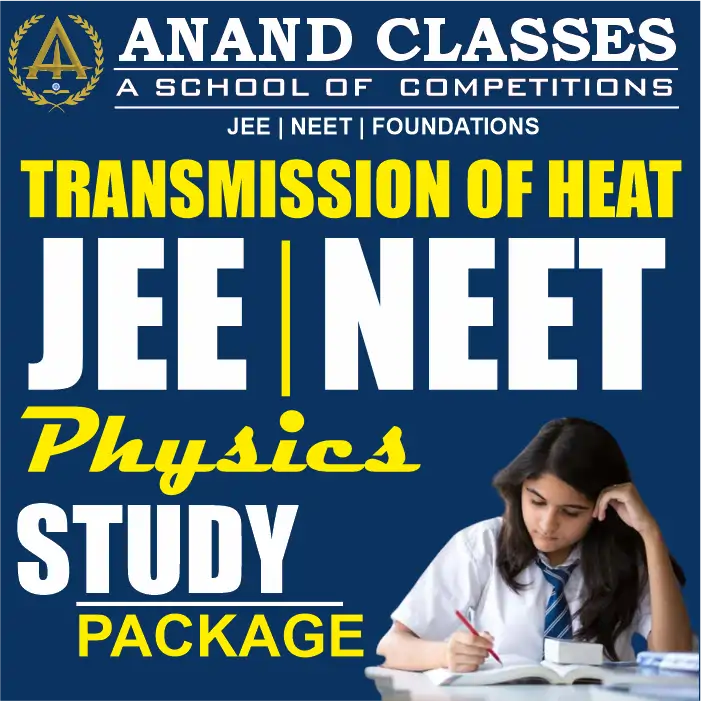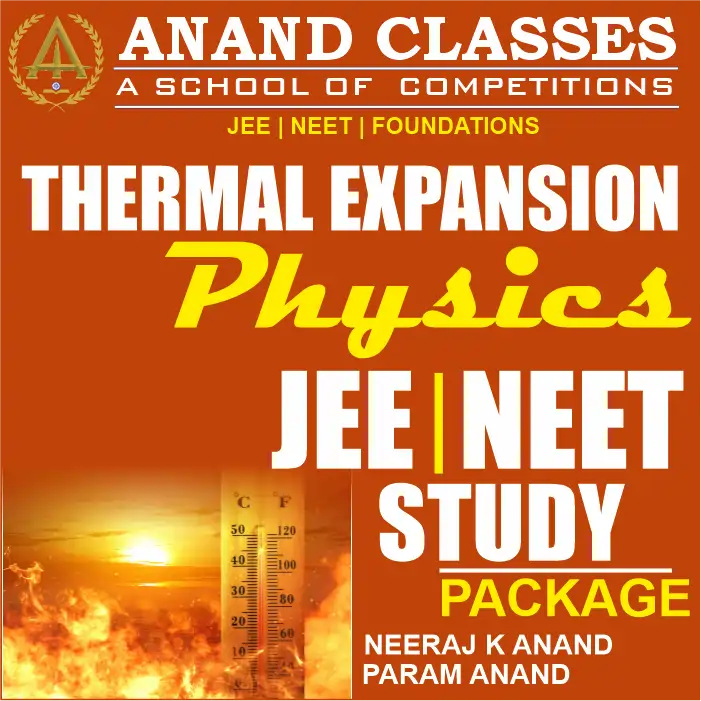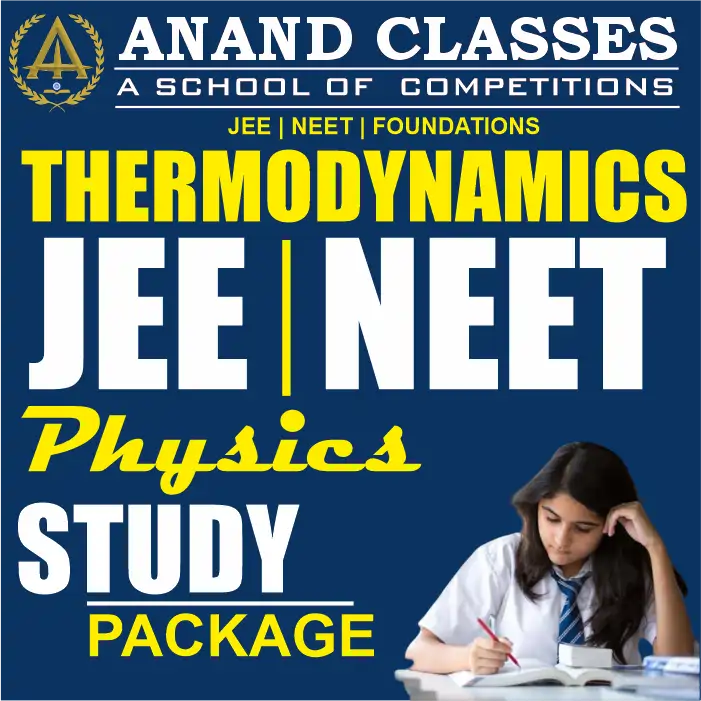Heat Transfer Notes With JEE NEET MCQS Physics Class 11 CBSE Study Material Full Chapter Download pdf-Anand Classes
What is Heat Transfer?
According to thermodynamic systems, heat transfer is defined as
“The movement of heat across the border of the system due to a difference in temperature between the system and its surroundings.”
How is Heat Transferred?
Heat can travel from one place to another in several ways. The different modes of heat transfer include:
- Conduction
- Convection
- Radiation
Meanwhile, if the temperature difference exists between the two systems, heat will find a way to transfer from the higher to the lower system.
What are the different Modes of Heat Transfer?
This is because of the phenomenon of heat transfer taking place between the pan full of water and the flame. It has been established that heat transfer takes place from hotter objects to colder objects.
When there are objects which are at different temperatures or there is an object at a different temperature from the surroundings, then the transfer of heat takes place so that the object and the surrounding, both reach an equilibrium temperature.
There are three modes of heat transfer.
- Conduction
- Convection
- Radiation
Heat Transfer Notes With JEE NEET MCQS Physics Class 11 CBSE Study Material Full Chapter Download pdf-Anand Classes
What is Conduction?
Conduction is defined as
The process of transmission of energy from one particle of the medium to another with the particles being in direct contact with each other.
An area of higher kinetic energy transfers thermal energy towards the lower kinetic energy area. High-speed particles clash with particles moving at a slow speed, as a result, slow speed particles increase their kinetic energy. This is a typical form of heat transfer and takes place through physical contact. Conduction is also known as thermal conduction or heat conduction.
Conduction Equation
The rate of conduction can be calculated by the following equation:
Q = KA (Thot – Tcold)/d
Where,
- Q is the transfer of heat per unit time
- K is the thermal conductivity of the body
- A is the area of heat transfer
- Thot is the temperature of the hot region
- Tcold is the temperature of the cold region
- d is the thickness of the body
The coefficient of thermal conductivity shows that a metal body conducts heat better when it comes to conduction.
Conduction Examples
Conduction example: When frying vegetables in a pan. Heat transfer takes place from flame to the pan and then to the vegetables.
Based on the conductivity of heat, substances can be classified as conductors and insulators. Substances that conduct heat easily are known as conductors and those that do not conduct heat are known as insulators.
Following are the examples of conduction:
- Ironing of clothes is an example of conduction where the heat is conducted from the iron to the clothes.
- Heat is transferred from hands to ice cube resulting in the melting of an ice cube when held in hands.
- Heat conduction through the sand at the beaches. This can be experienced during summers. Sand is a good conductor of heat.
Heat Transfer Notes With JEE NEET MCQS Physics Class 11 CBSE Study Material Full Chapter Download pdf-Anand Classes
What is Convection?
Convection is defined as
The movement of fluid molecules from higher temperature regions to lower temperature regions.
Convection Equation
As the temperature of the liquid increases, the liquid’s volume also has to increase by the same factor and this effect is known as displacement. The equation to calculate the rate of convection is as follows:
Q = hc A (Ts – Tf)
Where,
- Q is the heat transferred per unit time
- hc is the coefficient of convective heat transfer
- A is the area of heat transfer
- Ts is the surface temperature
- Tf is the fluid temperature
Convection Examples
Examples of convection include:
- Boiling of water, that is molecules that are denser move at the bottom while the molecules which are less dense move upwards resulting in the circular motion of the molecules so that water gets heated.
- Warm water around the equator moves towards the poles while cooler water at the poles moves towards the equator.
- Blood circulation in warm-blooded animals takes place with the help of convection, thereby regulating the body temperature.
What is Radiation?
Radiant heat is present in some or other form in our daily lives. Thermal radiations are referred to as radiant heat. Thermal radiation is generated by the emission of electromagnetic waves. These waves carry away the energy from the emitting body. Radiation takes place through a vacuum or transparent medium which can be either solid or liquid. Thermal radiation is the result of the random motion of molecules in matter. The movement of charged electrons and protons is responsible for the emission of electromagnetic radiation.
For example: In a microwave, the substances are heated directly without any heating medium.
Radiation heat transfer is measured by a device known as thermocouple. A thermocouple is used for measuring the temperature. In this device sometimes, error takes place while measuring the temperature through radiation heat transfer.
Radiation Equation
As temperature rises, the wavelength in the spectra of the radiation emitted decreases and shorter wavelengths radiations are emitted. Thermal radiation can be calculated by Stefan-Boltzmann law:
P = e σ A (Tr – Tc)4
Where,
- P is the net power of radiation
- A is the area of radiation
- Tr is the radiator temperature
- Tc is the surrounding temperature
- e is emissivity and σ is Stefan’s constant (σ = 5.67 × 10-8Wm-2K-4
Radiation Example
Following are the examples of radiation:
- Microwave radiation emitted in the oven is an example of radiation.
- UV rays coming from the sun is an example of radiation.
- The release of alpha particles during the decaying of Uranium-238 into Thorium-234 is an example of radiation.
Heat Transfer Notes With JEE NEET MCQS Physics Class 11 CBSE Study Material Full Chapter Download pdf-Anand Classes
Unit of Heat Transfer
| SI system | Joule |
| MKS system | cal |
| Rate of transfer of heat | KW |
Frequently Asked Questions – FAQs of Class 11 Physics Chapter Heat Transfer
What are the different modes of heat transfer?
There are primarily three modes of heat transfer: Conduction, Convection and Radiation.
What is heat conduction?
Heat conduction is a process in which heat is transferred from the hotter part to the colder part of a body without involving any actual movement of the body’s molecules.
Example: When frying vegetables in a pan. Heat transfer occurs from the flame to the pan and the vegetables.
What is heat convection?
Heat convection is a process in which heat is transferred in the liquid and gases from a higher temperature region to a lower temperature region. Convection heat transfer occurs partly due to the actual movement of molecules or due to the mass transfer.
Example. Heating of milk in a pan.
What is heat radiation?
Heat radiation is a process in which heat is transferred from one body to another without involving the medium’s molecules. Radiation heat transfer does not depend on the medium.
Example: In a microwave, the substances are heated directly without any heating medium.
What is the cause of heat transfer?
The difference in temperature is the primary cause of heat transfer.


































